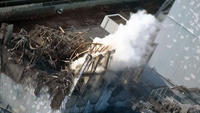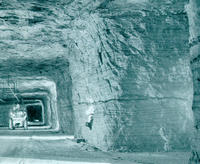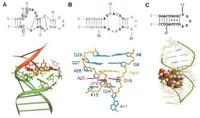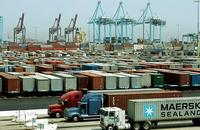-
OSU chemist developing solution to nerve agent exposure
Scientists are working to develop a new drug that will regenerate a critical enzyme in the human body that “ages” after a person is exposed to deadly chemical warfare agents; the drug will counter the effects of Tabun, VX, VR, Sarin, Soman, Cyclosarin, and Paraoxon, all of which take on a similar molecular structure upon aging
-
-
IAEA: after Japan, no more nuclear "business as usual"

The world cannot take a “business as usual” approach to nuclear power in the wake of the disaster in Japan, UN atomic watchdog chief Yukiya Amano said; “Thinking retrospectively, the measures taken by the operators as a safety measure (were) not sufficient to prevent this accident,” Amano said; he added that the crisis in Japan caused by the 11 March earthquake and tsunami “has enormous implications for nuclear power and confronts all of us with a major challenge”
-
-
Subterranean salt beds to keep U.S. nuclear waste

Beds of salt up to one kilometer thick lie within one or two kilometers of the surface across much of the United States; they were deposited hundreds of millions of years ago by evaporating seas; a new study suggests that since President Obama killed the only national nuclear waste burial program — the Yucca mountain site — the United States should look again at the pre-Yucca plan to bury nuclear waste in subterranean salt beds
-
-
Spray-on explosives detector
A chemist at Oklahoma State University has developed a spray-on material that detects explosives made from peroxides and renders them harmless; the material is a type of ink that contains nanoparticles of a compound of molybdenum. The ink changes color, from dark blue to pale yellow or clear, in the presence of explosives
-
-
Algae might help reduce nuclear waste
The humble algae — Closterium moniliferum — might one day soon be used to help separate strontium from calcium in nuclear waste; if successful, the process could lead to a reduction in the amount of nuclear waste that is left over from nuclear power facilities, and might even help in cleanup when accidents occur such as the one in Chernobyl, Ukraine, that spewed great quantities of strontium into the surrounding environment
-
-
Universal detector made of DNA building blocks

Aptamers are composed of the building blocks of the genetic material DNA; scientists show that aptamers can be used quantitatively to detect and accurately examine multifaceted substances; a method for detecting such diverse substances as antibiotics, narcotics, and explosives - in effect, a universal detector — has been developed by researchers at the Max Planck Institute for Polymer Research in Mainz
-
-
Japan widens evacuation radius
Japanese officials have enlarged the evacuation zone around the Fukushima Daiichi power plant, as workers continue their struggle to repair the damaged nuclear reactors; last Friday a “voluntary evacuation” of people still living within nineteen miles of the plant was issued; residents within nineteen miles have remained indoors unable to leave their homes to purchase basic supplies and companies have refused to deliver; the voluntary evacuation could add an even greater strain to existing temporary shelters; currently 242,881 people are still living in shelters around the country and officials are struggling to provide enough basic supplies like food, water, and sanitary goods
-
-
Biosensor improves pathogen detection in food, water
A nanotechnology-based biosensor being developed by Kansas State University researchers may allow early detection of both cancer cells and pathogens, leading to increased food safety and reduced health risks
-
-
Sector Report for Monday, 28 March 2011: Detection
This report contains the following stories.
Plus 1 additional story.
-
-
Global nuclear bomb sensors used to track Japan's radiation
A worldwide network of radiation sensors originally built to detect nuclear weapon tests is now being used by scientists to track radiation leaked from Japan’s Fukushima Daiichi nuclear power plant; over 280 sensors were installed to detect radiation from nuclear weapons testing; the sensors have detected several radioactive elements that are the byproducts of nuclear fission like iodine-131 and cesium-137 from Japan; experts studying the data disagree on the effect and size of the release, but assure the public that the effects are minimal as much of the radiation is being scattered across the Pacific
-
-
Half of EPA's radiation warning system in California defective
The defective sensors are part of EPA’s RadNet detection system which was created to provide an active warning system that would alert scientists and public health officials of any elevated levels of radiation so they can warn the public or take other protective measures; half of California’s twelve sensors have been sending data with “anomalies” to the EPA’s main laboratory; the faulty data results in delays of up to several hours; officials say that the sensors are fully functional and that the delays are a result of “glitches” in satellite transmissions; there are several other radiation sensors in the United States operated by local, state, and federal agencies
-
-
Washington nuclear sensors capable of detecting faintest amounts of radiation
The radiation detectors developed by the Pacific Northwest National Laboratory (PNNL) in Washington are so sensitive that they can detect trace amounts of radioactive material from hundreds of thousands of miles away; far from being a public health concern, the amount of radiation from Japan detected on the west coast of the United States was far less than what individuals receive from natural sources and is testament to the sensors extraordinary sensitivity; officials say that the PNNL’s sensors are a hundred times more sensitive than other radiation sensors; the PNNL facility is capable of picking up the faintest amounts of radioactive elements produced by nuclear reactions from the vast amounts of air particles in the world
-
-
San Francisco to regulate private biological agent detectors
Some firms have begun selling building owners and companies untested devices designed to detect anthrax and other biological agents, but city officials are worried that these will generate false alarms; in San Francisco city officials estimate that responding to a false alarm generated by a biological agent detector could cost as much as $700,000; legislation has been introduced to regulate these devices; the bill would require those who have biological agent detectors to pay an annual fee and owners would also be fined as much as $10,000 for false alarms; if passed, owners would have ninety days to register with the city
-
-
TSA looking for shoe scanning devices
DHS is seeking companies to which it will award a contract for shoe scanners; according to the Office of Federal Business Opportunities, the Shoe Scanning Device (SSD) system currently sought by the TSA and DHS “will be capable of detecting threat objects concealed in footwear without requiring passengers to remove their footwear as they pass through a security checkpoint. These threat objects include a wide variety of military, commercial, and homemade explosives or explosives devices”
-
-
Authors suggest ways to alleviate L.A. cargo port "constipation"

In January, the port of Los Angeles received more than 330,000 containers; the possibility that one of those 330,000 containers could have contained a dirty bomb, or worse, keeps security experts up at night; experts say that to ensure security and prevent logjams, the best approach to container security would be to replace the current system, which singles out only those containers whose documentation raises questions, with a system which will see terminal operators X-ray every container, regardless of its eventual destination; only those containers flagged during the low-level scan would be subjected to a more thorough search
-
More headlines
The long view
Prototype Self-Service Screening System Unveiled
TSA and DHS S&T unveiled a prototype checkpoint technology, the self-service screening system, at Harry Reid International Airport (LAS) in Las Vegas, NV. The aim is to provide a near self-sufficient passenger screening process while enabling passengers to directly receive on-person alarm information and allow for the passenger self-resolution of those alarms.
